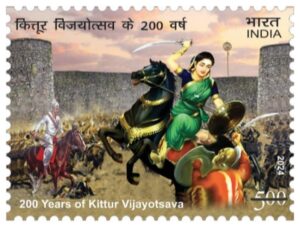Published on: October 29, 2024
RANI CHANAMMA AND KITTURU
RANI CHANAMMA AND KITTURU
NEWS – On the 200th anniversary of Kittur Vijayotsava a commemorative Postage stamp was released at the historic Kittur Rani Channamma Stage, Kittur Fort Premises.
THE KITTUR REBELLION
- Chenamma was born on October 23, 1778, in Kagati, a small village in present-day Belagavi district in Karnataka
- At the age of 15, she married Raja Mallasarja of Kittur, who ruled the province until 1816.
- After Mallasarja’s death in 1816, his eldest son, Shivalingarudra Sarja, ascended the throne. But it wasn’t long before Shivalingarudra’s health started deteriorating
- Kittur needed an heir apparent to survive. However, Shivalingarudra had no natural heir and Chennamma too had lost her son
- Before his death in 1824, Shivalingarudra adopted a child, Shivalingappa, as the successor. However, the British East India Company refused to recognise Shivalingappa as the successor of the kingdom under the ‘doctrine of lapse’
- Under the doctrine, any princely state without a natural heir would collapse and would be annexed by the Company, and John Thackery, the British official at Dharwad, launched an attack on Kittur in October 1824
- Thackery ordered two guns of horse artillery and a company of infantry to enter the fort (Book Ranis and the Raj by historian Queeny Pradhan). The Kittur army, under the leadership of Rani Chennamma, retaliated and opened tremendous fire. Thackeray was killed and Rani Chennamma emerged victorious
- However, this victory was short-lived. On December 3, 1824, the British army attacked the Kittur Fort and captured it. Rani Chennamma and her family were imprisoned and jailed at the fort in Bailhongal, where she died in February 21, 1829

